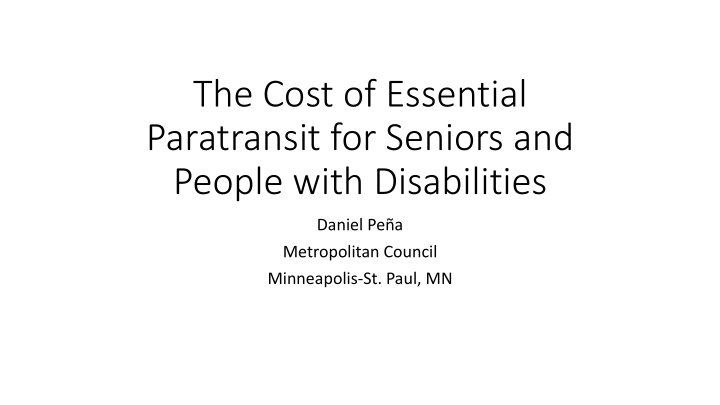



The Cost of Essential Paratransit for Seniors and People with Disabilities Daniel Peña Metropolitan Council Minneapolis-St. Paul, MN
Agenda • Discuss how to address the issues that we are facing in paratransit today • Paratransit in the Twin Cities • Metro Mobility Needs Assessment Study • What is being done throughout the country
Introduction • Twin Cities, Minneapolis-Saint Paul, Minnesota • Population: 3,000,000 • Seven Counties • Metropolitan Council: Twin Cities MPO • Metro Mobility: Twin Cities ADA Paratransit Service • Ran by the Metropolitan Council
Metro Mobility Service Area • Both Federally Mandated and State Mandated Service Areas
Metro Mobility Issues • Demand for paratransit service is increasing rapidly • Service productivity has remained relatively unchanged • Increased operating costs are stressing our resources
Annual Metro Mobility Trips 2,500,000 Increased Demand 2,000,000 - Metro Mobility ridership increased by 33% over five years 1,500,000 - Ridership grew from 1.5 million annual rides in 2011 to 2 million rides in 2015 1,000,000 500,000 0 2011 2012 2013 2014 2015
Increased Demand 2,500,000 2,000,000 - Demand growing faster than forecasted - By 2015 ridership was already 1,500,000 330,000 riders greater than the highest 2020 projections 1,000,000 500,000 0 2010 2015 2020 Low End Projection High End Projection Actual
No Increases in Service Productivity Productivity 2.50 2.00 Passengers per Revenue Hour 1.50 1.00 0.50 0.00 2011 2012 2013 2014 2015
Increased Annual Metro Mobility Operating Costs and Revenue Operating Costs $60,000,000 $50,000,000 - Annual operating expenses for Metro Mobility increased by 41% $40,000,000 between 2011 to 2015 from $40 Million to $56 Million $30,000,000 $20,000,000 $10,000,000 $0 2011 2012 2013 2014 2015 Operating Expense Passenger Revenue
Metro Mobility Needs Assessment • Study to understand the demand for paratransit service • Reviewed peer systems policies and performance • Analyzed current ridership demand • Developed a user friendly model for forecasting paratransit ridership for 2020, 2030 and 2040 • Analyzing ridership impacts of possible policy scenarios
Peer Analysis Baltimore MTA L.A. Access Houston METROLift Denver RTA Milwaukee MCTS Cleveland RTA Austin Capital Metro Portland TriMET LIFT 1.20 1.00 pita Capit per Ca 0.80 Trips p 0.60 0.40 0.20 0.24 0.24 0.35 0.38 0.43 0.46 0.50 0.56 0.59 0.61 0.87 1.07 0.00
Trip Analysis
Demand Analysis
Model Development
Metro Mobility Ridership Forecast Model
Metro Mobility Forecast Model
Metro Mobility Forecast Model
Policy Scenarios • What would demand and operating expenses be if we were to… • Only provide service in federally mandated areas? • Expand service further to communities that are currently not being served? • More strictly enforced conditional eligibility criteria? • Raised or lowered fares?
Paratransit Innovations • Public Private Partnerships • MBTA On-Demand Paratransit Pilot Program • Improved Integration With Technology • Onboarding • Reservations • Dispatch and Routing • User Experience • SilverRide
Questions • What new tools and approaches are there for providing paratransit service? • As new technologies and private-public partnerships emerge, how well are the special needs of our community members being met? • What can agencies and partners do to deliver quality service at a lower cost?
Recommend
More recommend